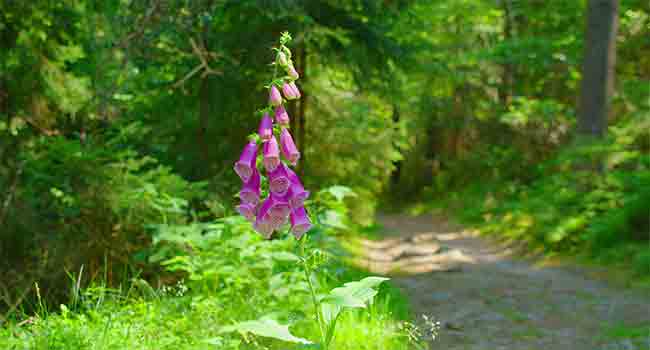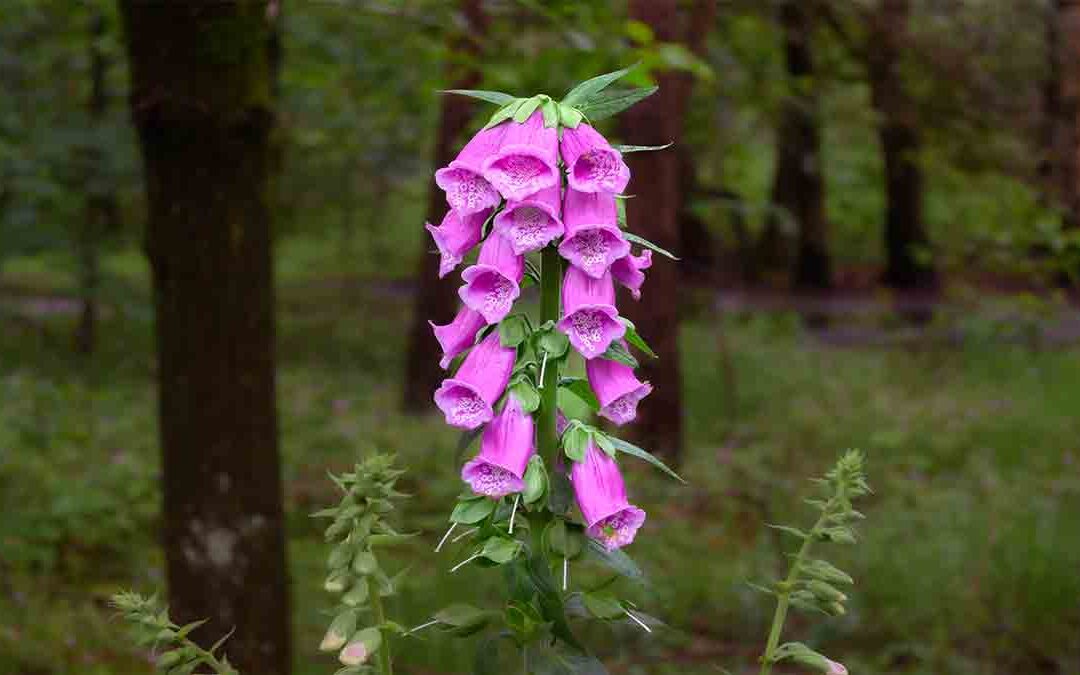The foxglove, with its towering spires of bell-shaped blooms, is a sight to behold in any garden.
The Foxglove’s Journey: A Brief Overview
The foxglove, primarily a biennial plant, embarks on a two-year journey to complete its life cycle.
Seed Germination: The First Steps
Sowing the Seeds
Foxglove seeds are remarkably tiny, resembling dust particles.
Tiny Sprouts Emerge
Once the seeds germinate, delicate seedlings emerge, showcasing their first pair of true leaves. These seedlings are vulnerable and require careful attention. Adequate moisture and sunlight are crucial for their survival and growth. As they mature, they develop a rosette of leaves, preparing for the next stage of their life cycle.
The First Year: Laying the Groundwork – The Rosette Stage
Leafy Rosette Development
As the foxglove seedlings grow, they channel their energy into developing a dense rosette of leaves close to the ground. These leaves, often described as spoon-shaped or lance-shaped, act as solar panels, capturing sunlight and converting it into energy through photosynthesis. This energy is crucial for the plant’s survival and, more importantly, for fueling the spectacular flowering display that awaits in the following year.
Preparing for the Grand Show
The rosette stage is a period of quiet preparation. The foxglove diligently stores the energy it harvests from the sun in its roots, building up reserves for the demanding task of flowering. This energy storage is vital for the plant to produce a tall, robust flowering stalk and an abundance of blooms.
The Second Year: A Symphony of Blooms
Towering Stalk Emergence
In the second year, the foxglove undergoes a dramatic transformation. A central stalk emerges from the heart of the rosette, shooting skyward with remarkable speed. This stalk can reach impressive heights, sometimes exceeding six feet, creating a vertical spectacle in the garden.
The Floral Spectacle
As the stalk elongates, it becomes adorned with a profusion of tubular flowers. These blooms, resembling tiny bells or thimbles, open in succession from the bottom of the stalk upwards, creating a cascading display of color. The flowers exhibit a wide range of hues, including pinks, purples, yellows, whites, and even bi-colored varieties. Their intricate patterns and markings serve as beacons, attracting a diverse array of pollinators, including bees, butterflies, and hummingbirds.
Pollination and Seed Production
Pollinators play a crucial role in the foxglove’s life cycle. As they visit the flowers in search of nectar, they inadvertently transfer pollen from one flower to another, facilitating fertilization. Once fertilized,
Seed Dispersal and New Beginnings
Seed Capsule Maturation
After flowering, the seed capsules mature and gradually turn brown and dry. As they ripen, they split open, revealing countless minute seeds.
Wind and Animal Aid
Nature has equipped foxgloves with ingenious mechanisms for seed dispersal. The tiny seeds are easily carried by the wind, allowing them to travel considerable distances and colonize new areas. Additionally, the seeds can become entangled in the fur of animals or the clothing of humans, further aiding their dispersal.
The Cycle Continues
Once the seeds find suitable conditions, they germinate, and the cycle begins anew. Each seed carries the potential to produce another magnificent foxglove, ensuring the continuation of this captivating species.
Delving Deeper
Foxglove Varieties
The world of foxgloves is a treasure trove of diversity. From the classic ‘Excelsior’ hybrids with their towering stalks and densely packed blooms to the more delicate ‘Camelot’ series with their pastel-colored flowers, there’s a foxglove to suit every taste and garden style. Some varieties, like ‘Candy Mountain,‘ boast unique, upward-facing flowers, while others, like ‘Dalmatian Peach,‘ showcase captivating speckled patterns. Exploring the myriad of foxglove cultivars is a delightful journey in itself.
Growing Tips
While foxgloves are relatively low-maintenance, a few key considerations can ensure optimal growth and flowering. They thrive in full sun to partial shade and prefer well-drained soil rich in organic matter. Adequate spacing is essential, as overcrowding can lead to leggy growth and reduced flowering. Deadheading spent blooms encourage the plant to produce more flowers, prolonging the display.

Climate and Variety Selection:
-
Temperate Climates (UK, Ireland, New Zealand): These regions, with their mild summers and cool winters, provide ideal conditions for most foxglove varieties. Classic choices like the ‘Excelsior’ hybrids and ‘Camelot’ series thrive here. Consider experimenting with the ‘Dalmatian’ series for unique speckled blooms or ‘Candy Mountain’ for its upward-facing flowers.
-
Hot and Humid Summers (Southern US, Australia): In these regions, opt for heat-tolerant foxglove varieties like ‘Foxy’ mix or those from the ‘Gloxiniaeflora’ group. These cultivars are better equipped to withstand higher temperatures and humidity.
-
Cold Winters (Canada, Northern US): Choose hardy foxglove varieties that can withstand harsh winters. ‘Camelot Lavender’ and ‘Pam’s Choice’ are known for their cold tolerance. Mulching around the base of the plants can provide additional protection during freezing temperatures.
Potential Challenges
-
Slugs and Snails: These pests can be particularly troublesome in damp climates. Employ organic control methods like copper tape, diatomaceous earth, or beer traps to protect your foxgloves.
-
Powdery Mildew: High humidity and poor air circulation can promote powdery mildew. Choose resistant varieties, space plants adequately, and avoid overhead watering to prevent this fungal disease.
-
Self-Seeding: While self-seeding can be desirable for naturalizing foxgloves, it can also lead to overcrowding. Deadhead spent flowers promptly if you want to control their spread.
Foxglove Life Cycle FAQs: Your Questions Answered
1. Are foxgloves perennials or annuals?
- Foxgloves are primarily biennial plants, meaning they complete their life cycle in two years. However, some varieties can behave as short-lived perennials, returning for a few years under ideal conditions.
2. How tall do foxgloves grow?
- The height of foxgloves varies depending on the variety. Some cultivars can reach impressive heights of 6 feet or more, while others remain more compact, reaching 2-3 feet tall.
3. When do foxgloves bloom?
- Foxgloves typically bloom in their second year, usually in late spring or early summer. The flowering period can last for several weeks, depending on the variety and growing conditions.
4. Are foxgloves poisonous?
- Yes, all parts of the foxglove plant contain toxic cardiac glycosides, which can be harmful if ingested. It’s essential to handle them with care and keep them out of reach of children and pets.
5. Can I grow foxgloves from seed?
- Yes, foxgloves are readily grown from seed. Sow the seeds directly in the garden in spring or start them indoors 6-8 weeks before the last frost.
6. Do foxgloves attract pollinators?
- Absolutely! Foxgloves are a magnet for pollinators, especially bees, butterflies, and hummingbirds. Their tubular flowers provide a rich source of nectar, making them a valuable addition to any pollinator-friendly garden.
7. How do I care for foxgloves?
- Foxgloves prefer full sun to partial shade and well-drained soil. Water them regularly, especially during dry periods. Deadhead spent flowers to encourage continuous blooming.
8. Can I grow foxgloves in containers?
- Yes, you can grow foxgloves in containers, but choose a large pot to accommodate their root system. Ensure adequate drainage and provide regular watering and fertilization.
9. Do foxgloves self-seed?
- Yes, foxgloves readily self-seed, which can be a blessing or a curse depending on your gardening goals. If you want to control their spread, deadhead the flowers before they go to seed.
10. What are some common problems with foxgloves?
- Foxgloves can be susceptible to powdery mildew, especially in humid conditions. Ensure good air circulation around the plants and avoid overhead watering. Aphids and slugs can also be occasional pests.
Foxglove Life Cycle Conclusion
The foxglove life cycle is a beautiful journey, from seed to towering bloom, showcasing nature’s artistry. Understanding its stages empowers successful cultivation while appreciating its toxicity ensures responsible gardening. It serves as a reminder of nature’s interconnectedness and enduring power.
Related: Foxglove Look Alike

